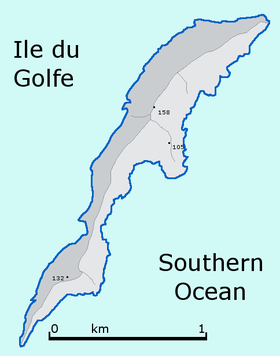geo.wikisort.org - Island
The Ile du Golfe is a limestone island located close to the south-western coast of Tasmania, Australia. The long, narrow dolphin-shaped 68-hectare (0.26 sq mi) island is part of the Maatsuyker Islands Group, and comprises part of the Southwest National Park and the Tasmanian Wilderness World Heritage Site.[1][2]
 A map of Ile Du Golfe | |
| Geography | |
|---|---|
| Location | South West Tasmania |
| Coordinates | 43°34′12″S 146°31′12″E |
| Archipelago | Maatsuyker Islands Group |
| Adjacent bodies of water | Southern Ocean |
| Area | 68 ha (170 acres)[1] |
| Highest elevation | 156 m (512 ft) |
| Administration | |
Australia | |
| State | Tasmania |
| Region | South West |
| Demographics | |
| Population | Unpopulated |
The island's highest point is 156 metres (512 ft) above sea level.
Fauna
The island is part of the Maatsuyker Island Group Important Bird Area, identified as such by BirdLife International because of its importance as a breeding site for seabirds.[3] Recorded breeding seabird and wader species are the little penguin, short-tailed shearwater (134,000 pairs), fairy prion (356,000 pairs), Pacific gull, silver gull, sooty oystercatcher and black-faced cormorant. The swamp antechinus has been recorded. Reptiles present include the Tasmanian tree skink, metallic skink and three-lined skink.[2]
See also
- South East Cape
- South West Cape
- List of islands of Tasmania
References
- "Small Southern Islands Conservation Management Statement 2002" (PDF). Tasmania Parks and Wildlife Service. 2002. Archived from the original (PDF) on 22 August 2006. Retrieved 20 July 2006.
- Brothers, Nigel; Pemberton, David; Pryor, Helen; & Halley, Vanessa. (2001). Tasmania’s Offshore Islands: seabirds and other natural features. Tasmanian Museum and Art Gallery: Hobart. ISBN 0-7246-4816-X
- BirdLife International. (2011). Important Bird Areas factsheet: Maatsuyker Island Group. Downloaded from http://www.birdlife.org on 09/08/2011.
На других языках
- [en] Ile du Golfe
[it] Ile du Golfe
Ile du Golfe è un'isola situata a sud della Tasmania (Australia) nel mar di Tasman. L'isola appartiene alla municipalità di Huon Valley, una delle Local government area della Tasmania e si trova all'interno del Southwest National Park[2] che a sua volta fa parte della Tasmanian Wilderness World Heritage Area.[3][4]Другой контент может иметь иную лицензию. Перед использованием материалов сайта WikiSort.org внимательно изучите правила лицензирования конкретных элементов наполнения сайта.
WikiSort.org - проект по пересортировке и дополнению контента Википедии
